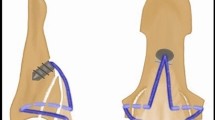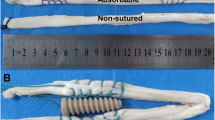Abstract
Different types of intraosseous suture anchors can be used for thumb ulnar collateral ligament (UCL) repair surgery. Some of them have already been tested biomechanically in intact bone; however, there exists little knowledge of their stability when implanted in avulsion fracture. In this biomechanical in vitro study, three anchor types (hard, soft and novel BoneWelding) were tested on 24 fresh frozen human thumbs from 12 body donors. After the repair of an iatrogenic ligamentous UCL rupture, the thumbs were cyclically loaded. A new set of anchors was implanted at the contralateral radial side of the same specimen into an iatrogenic avulsion fracture and pulled out of the bone. The most common mode of failure in ligamentous UCL repairs was the suture–ligament interface, especially when using soft anchors. In avulsion fractures, the novel anchor withstood significantly higher pullout forces than the hard or soft anchor (65 N vs. 42 N vs. 27 N; p = .006). The BW anchor provides sufficient anchorage in trabecular bone for UCL repair in case of avulsion fractures.





Similar content being viewed by others
References
Avery DM, Caggiano NM, Matullo KS (2015) Ulnar collateral ligament injuries of the thumb: a comprehensive review. Orthop Clin North Am 46(2):281–292
Chuter GSJ, Muwanga CL, Irwin LR (2009) Ulnar collateral ligament injuries of the thumb: 10 years of surgical experience. Injury 40(6):652–656
Cooper JG, Johnstone AJ, Hider P et al (2005) Local anaesthetic infiltration increases the accuracy of assessment of ulnar collateral ligament injuries. Emerg Med Australas 17(2):132–136
Coyle MP (2003) Grade III radial collateral ligament injuries of the thumb metacarpophalangeal joint: treatment by soft tissue advancement and bony reattachment. J Hand Surg Am 28(1):14–20
Crowley TP, Stevenson S, Taghizadeh R et al (2013) Early active mobilization following UCL repair with Mitek bone anchor. Tech Hand Up Extrem Surg 17(3):124–127
Firoozbakhsh K, Yi IS, Moneim MS et al (2002) A study of ulnar collateral ligament of the thumb metacarpophalangeal joint. Clin Orthop Relat Res 403:240–247
Gluck JS, Balutis EC, Glickel SZ (2015) Thumb ligament injuries. J Hand Surg Am 40(4):835–842
Harley BJ, Werner FW, Green JK (2004) A biomechanical modeling of injury, repair, and rehabilitation of ulnar collateral ligament injuries of the thumb. J Hand Surg Am 29(5):915–920
Hintermann B, Holzach PJ, Schutz M et al (1993) Skier’s thumb—the significance of bony injuries. Am J Sports Med 21(6):800–804
Jarrett CD, McGillivary GR, Hutton WC (2010) The 2.5 mm PushLock suture anchor system versus a traditional suture anchor for ulnar collateral ligament injuries of the thumb: a biomechanical study. J Hand Surg Eur 35(2):139–143
Katolik LI, Friedrich J, Trumble TE (2008) Repair of acute ulnar collateral ligament injuries of the thumb metacarpophalangeal joint: a retrospective comparison of pull-out sutures and bone anchor techniques. Plast Reconstr Surg 122(5):1451–1456
Kottstorfer J, Hofbauer M, Krusche-Mandl I et al (2013) Avulsion fracture and complete rupture of the thumb radial collateral ligament. Arch Orthop Trauma Surg 133(4):583–588
Lange T, Schmoelz W, Gosheger G et al (2017) Is a gradual reduction of stiffness on top of posterior instrumentation possible with a suitable proximal implant? A biomechanical study. Spine J 17(8):1148–1155
Langer MF, Hermann K, Oeckenpöhler S et al (2015) Ulnare Kollateralbandplastik des Daumengrundgelenks bei chronischer Instabilität. Oper Orthop Traumatol 27(5):380–393
Madan SS, Pai DR, Kaur A et al (2014) Injury to ulnar collateral ligament of thumb. Orthop Surg 6(1):1–7
Malik AK, Morris T, Chou D et al (2009) Clinical testing of ulnar collateral ligament injuries of the thumb. J Hand Surg Eur Vol 34(3):363–366
Michaud EJ, Flinn S, Seitz WH, JR (2010) Treatment of grade III thumb metacarpophalangeal ulnar collateral ligament injuries with early controlled motion using a hinged splint. J Hand Ther 23(1):77–82
Moharram AN, Ashraf N (2013) Repair of thumb metacarpophalangeal joint ulnar collateral ligament injuries with microanchors. Ann Plast Surg 71(5):500–502
Obremskey WT, Pappas N, Attallah-Wasif E et al (2005) Level of evidence in orthopaedic journals. J Bone Joint Surg Am 87(12):2632–2638
Patel S, Potty A, Taylor EJ et al (2010) Collateral ligament injuries of the metacarpophalangeal joint of the thumb: a treatment algorithm. Strategies Trauma Limb Reconstr 5(1):1–10
Rhee PC, Jones DB, Kakar S (2012) Management of thumb metacarpophalangeal ulnar collateral ligament injuries. J Bone Joint Surg Am 94(21):2005–2012
Riederer B, Brenner E, Bueno-Lopez J et al (2008) The legal and ethical framework governing Body Donation in Europe—1st update on current practice. Eur J Anat 16:1–21
Rocchi L, Merolli A, Morini A et al (2014) A modified spica-splint in postoperative early-motion management of skier’s thumb lesion: a randomized clinical trial. Eur J Phys Rehabil Med 50(1):49–57
Samora JB, Harris JD, Griesser MJ et al (2013) Outcomes after injury to the thumb ulnar collateral ligament—a systematic review. Clin J Sport Med 23(4):247–254
Thomopoulos S, Zampiakis E, Das R et al (2008) The effect of muscle loading on flexor tendon-to-bone healing in a canine model. J Orthop Res 26(12):1611–1617
Ziegler C, Neshkova I, Schmidt K et al (2016) Operative Behandlung der ulnaren Seitenbandläsion am Daumengrundgelenk. Oper Orthop Traumatol 28(2):111–126 (quiz 127)
Acknowledgements
The authors wish to thank all individuals who donated their bodies and tissues for the advancement of education and research.
Funding
The authors received no financial support for the research, authorship, and/or publication of this article.
Author information
Authors and Affiliations
Corresponding author
Ethics declarations
Conflict of interest
The company SportWelding (Schlieren, CH) supported the laboratory cost of this study. The study, however, was performed independently at the biomechanical laboratory of the Department for Trauma Surgery at the Medical University of Innsbruck. The authors declare that they have no conflict of interest.
Informed consent
Twenty-four human thumbs from twelve body donors were used in this study. The bodies were donated by people who had given their written informed consent for their use for scientific and educational purposes prior to death.
Rights and permissions
About this article
Cite this article
Wagner, M., Schmoelz, W., Stofferin, H. et al. Biomechanical in vitro comparison of suture anchors for thumb UCL repair. Arch Orthop Trauma Surg 138, 435–442 (2018). https://doi.org/10.1007/s00402-018-2877-1
Received:
Published:
Issue Date:
DOI: https://doi.org/10.1007/s00402-018-2877-1




